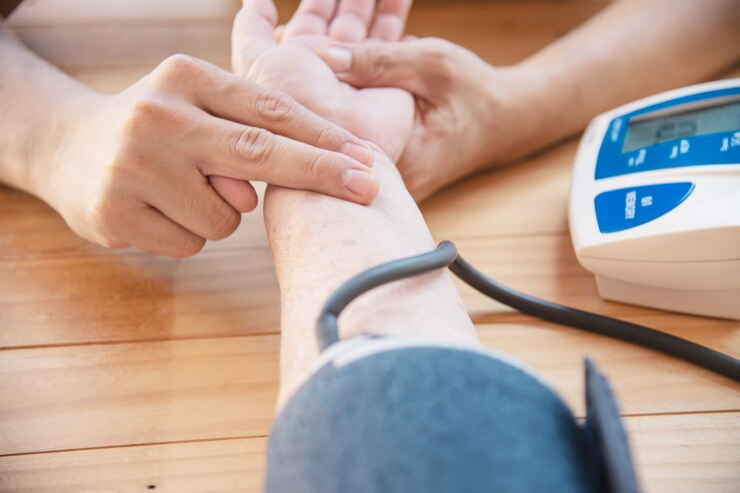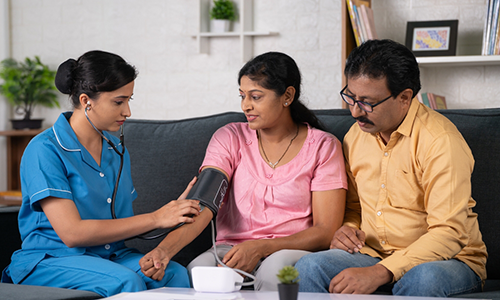1. Low Blood Pressure -
Low blood pressure or hypotension in medical terms, is when your blood pressure is lower than expected. It can happen for some unknown reason or as a symptom of any other health complication. It may have a wide range of symptoms or sometimes none. But once the symptoms start appearing, you need immediate medical attention. So, there are better options regarding your health than overlooking the symptoms.
Hypotension is categorized into two categories -
• Absolute hypotension - Absolute hypotension is a condition when your blood pressure is below 90/60 millimeters of mercury (mmHg).
• Orthostatic hypotension - Orthostatic hypotension is when your blood pressure remains lower than the expected ranges for a longer period even after getting up from a lying or relaxing position. When you change your position in a relaxing posture, it is normal for your blood pressure to drop a little for a brief time (1 to 2 minutes) but a drop in your blood pressure for a longer time is concerning. For orthostatic hypotension, there must be a drop of 20 mm Hg for systolic (top) pressure and more than 10 mm Hg of drop of diastolic (bottom) pressure. Orthostatic hypotension is also known as postural hypotension solely because it happens with a change in your postures.
The basic requirement to measure blood pressure involves two measuring numbers -
• Systolic (top number) is pressure on your arteries each time your heart beats.
• Diastolic (bottom number) is the pressure on your arteries between the heartbeats.
Hypotension is common among elderly people above the age of 50 but it can affect people of any age and background, depending on various reasons and conditions. It can also affect younger people who are very much physically active and do regular workouts and exercises with no symptoms to have any doubt of hypotension.
Symptoms and signs of low blood pressure -
Low blood pressure or hypotension can have a wide range of symptoms that include -
• Lightheaded
• Dizziness
• Vomiting and nausea
• Fast breathing
• Weakness and fatigue
• Feeling tired and sluggish
• Trouble concentrating
• Agitation and irritation
If you have hypotension and symptoms are showing then it is important to know the cause of it to deal with the situation. As your body gets older, a slow decrease in your blood pressure is normal. That’s why hypotension is a common condition among older people. However, a rapid decrease in your blood pressure means certain body parts are not getting enough flow of blood. That can have disruptive, uncomfortable or dangerous effects on your body.
Many people do not have any symptoms of low blood pressure and they do not know anything about the condition unless they measure their blood pressure. Usually, the human body can maintain normal blood pressure and prevent it from dropping too much by increasing the heart rate or narrowing the blood vessels by constricting them. Symptoms appear when your body cannot maintain regular blood pressure.
Possible signs of blood pressure -
• Too slow or too high heart rate
• Pale skin color or lighter than your usual skin color
• Cool kneecaps
• Low cardiac output
• Less amount of urine
Cause of the low blood pressure or hypotension -
• Orthostatic hypotension - Sudden change in your body position and indulging in physical work and the body takes more time to compensate with blood flow.
• Central nervous diseases - Complications like Parkinson’s disease, affect how the nervous system controls your blood pressure.
• Low blood volume because of any injury that leads to blood loss.
• Life-threatening diseases like arrhythmias (irregular heart rhythms), collapsed lung, pulmonary embolism (PE), and heart attack.
• Allergic reactions such as anaphylaxis and sepsis (immune reaction to infection).
• Heart and lung complications such as weak heart muscle, too high or too slow heart rate, and lung complications.
• Medication - Medicines to treat conditions like heart failure, depression, neurological problems, erectile dysfunction, and high pressure can also lead to low blood pressure.
• Pregnancy - There is chance of orthostatic hypotension in first or second trimesters of pregnancy.
• Extreme body temperature: Extreme body temperature such as too cold or too hot can affect hypotension.
Tests to diagnose low blood pressure or hypotension -
Diagnosing low blood pressure is easy, and only requires measuring your blood pressure. However, to know the root cause of the complication your healthcare provider may do some tests to rule out any danger.
Blood or urine test - A blood or urine test is performed to look at the potential conditions -
- Diabetes
- Deficiency of vitamin
- Thyroid problem
- Anemia
- Pregnancy
Imaging test: If your healthcare provider suspects a heart or lung complication, they may perform some of the following imaging tests -
- X-rays
- CT scans
- MRI
- Echocardiogram
Diagnostic test -
- - ECG or EKG
- - Tilt table test
- - Exercise stress testing

















